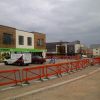
Lessons learned from Cranbrook says report
Devon County Council's Scrutiny Committees have today (Friday 11 September) reported their findings from a review of the Cranbrook development in East Devon.
The Task Group completed its review of the past, current and future development of the new town, having examined issues such the current physical and social infrastructure, the impact of the development on public services, and Cranbrook’s longer term opportunities.
The task group’s report states that “a huge amount has been achieved” since building work began at Cranbrook in June 2011.
Cranbrook held its first elections in May and it now has its own Town Council to serve its estimated current population of around 2,500 people living in just over 1,000 homes.
The first residents moved to the town in summer 2012 and St Martin's Primary School opened its doors shortly after, when less than 50 homes were occupied. The school opened with just 32 children, but over 400 were attending by the end of the Summer Term. The Cranbrook Education Campus opened its doors to primary and secondary school children for the first time this month.
Cranbrook is served by a half-hourly bus service and it has a network of cycle and walking routes which link to Exeter. The railway station is due to open this autumn, but its delivery is later than initially planned.
Although the Cranbrook Medical Centre opened in April 2015, the report says that there was a “complete lack of healthcare, social care or other professional support during the first 18-24 months”. The GP surgery will need a larger premises in future to have sufficient capacity for the town’s expanding population. The task group also found that the pharmacy, which is in a temporary premises, would be better served if it was located with the GP surgery.
Residents in the town benefit from reduced energy prices, thanks to the district heating system which supplies Cranbrook and SkyPark. The system, which is the first low-density district heating system in the country, was hailed a success.
The report highlights some problems which need addressing as well as some areas where things could have been done differently. It states that “Cranbrook is not yet future proof”, as there is currently no provision of bungalows, retirement homes, extra care housing and nursing homes for older residents.
It also highlights that the planning process for “crucial community infrastructure”, such as a leisure centre, library, children’s centre and town council offices, is only just starting despite the first residents moving in more than three years ago. However, the Younghayes Community Centre was completed ahead of schedule.
Councillor Andrew Moulding, who chaired the task group and is Chairman of the Place Scrutiny Committee, said: “Although the development of the town is a huge success, this task group uncovered many issues which need resolving, such as planning future development in a co-ordinated manner, accelerate provision for older children and young people, and identify the healthcare, social care and general wellbeing needs of the residents in order to plan future services.
“The task group commenced at a time when the development at Cranbrook reached a milestone with the near-completion of Phase 1 and with the imminent development of Sherford, a new town of similar size and scope in the South Hams close to the border with Plymouth.”
The task group’s final report contains a number of recommendations and lessons learnt. These include:
- The establishment of a multi-disciplinary team across Devon County Council to plan and implement the provision of future services in Cranbrook, Sherford, and large extensions to existing settlements. This team would cover everything from waste management to public health.
- Provision of services for older children and young people should be enhanced until permanent services are established.
- The establishment of a strategic health and wellbeing group to oversee the development of a health and wellbeing strategy for the town.
The report is available here http://www.devon.gov.uk/cma_report.htm?cmadoc=report_cs1519.html

















